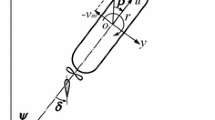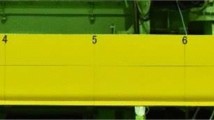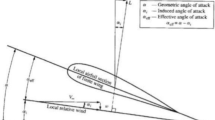Abstract
A simulation model for the flexural dynamics of a slender ship undergoing heave and pitch in regular waves is presented. The heave and pitch motions are found from the strip theory of Gerritsma and Beukelman [1] which is known to be experimentally validated. It is assumed that the ship structure is sufficiently stiff so that bending deformations do not significantly alter the wave field and hence the hydrodynamic loads determined from the strip theory may be used as inputs to the flexural model. The flexural dynamics is modeled by applying the hydrodynamic loads to a lumped-mass beam model and the equations of motion are formulated using the methods of Kane and Levinson [2]. The flexural model can capture large deformation behavior and is tested by demonstrating convergence to a known analytic solution. The model is easily implemented and may be used to evaluate time histories of bending moment responses to waves as well as to slamming events if the slamming load is known or estimated. Some typical results are presented.






Similar content being viewed by others
References
Gerritsma, J., Beukelman, W.: Analysis of the modified strip theory for the calculation of ship motions and wave bending moments. Int. Shipbuil. Prog. 14(156), 319–337 (1967)
Kane, T.R., Levinson, D.: Dynamics. Theory and Applications, Mc-Graw-Hill Book Company (1985)
Hirdaris, S.E., Temarel, P.: Hydroelasticity of ships: recent advances and future trends,Proc. IMechE Vol. 223 Part M: J. Engineering for the Maritime Environment, (2009)
Chen, X.J., Wu, Y.S., Cui, W.C., Jensen, J.J.: Review of hydroelasticity theories for global response of marine structures. Ocean Engineering 33, 439–457 (2006)
Rajendran, S., Guedes-Soares, C.: Numerical investigation of the vertical response of a containership in large amplitude waves. Ocean Eng. 123, 440–451 (2016)
Kara, F.: Time domain prediction of hydroelasticity of floating bodies. Appl. Ocean Res. 51, 1–13 (2015)
Blok, J., Beukelman, W.:The High-Speed Displacement Ship Systematic Series Hull Forms-Seakeeping Characteristics, Report No. 675-P, Ship Hydromechanics Laboratory,Delft,SNAME Annual Meeting,New York, (1984)
Veen, D.J., Gourlay, T.P.: A combined strip theory and smoothed particle hydrodynamics approach for estimating slamming loads on a ship in head seas. Ocean Eng. 43, 64–71 (2012)
MATLAB, R.: MathWorks Inc.,Natick,MA,USA (2017b)
Banerjee, A.K.: Dynamics and control of the wisp shuttle-antennae system, the journal of the astronautical sciences, vol. 41, no. 1. Jan.Mar. 1993, 73–90 (1993)
Banerjee, A.K., Nagarajan, S.: Efficient simulation of large overall motion of beams undergoing large deflection. Multibody Syst. Dyn. 1(1), 113–126 (1997)
Bisshopp, K.E., Drucker, D.C.: Large deflection of cantilever beams. Quart. Appl. Mat. 3, 272–275 (1945)
Acknowledgements
The financial support of the National Research Council of Canada is gratefully acknowledged.
Author information
Authors and Affiliations
Corresponding author
Additional information
Publisher's Note
Springer Nature remains neutral with regard to jurisdictional claims in published maps and institutional affiliations.
Appendices
Appendix A : steady state heave and pitch computation from Gerritsma and Beukelman strip theory [1]
The hydrodynamic forces on a strip at position s are given by Eq. (1). Summation of forces and moments over the length of the ship gives the equations of motions for heave and pitch in the form
where
and
Substituting \(z=\overline{z}e^{-i\omega _{e}t}\ ,\ \theta =\overline{\theta } e^{-i\omega _{e}t}\) into equation (A.1) gives
where the entries of matrix R are
Equation (A.2) is solved for \(\overline{z}\), \(\overline{\theta }\). The steady state solutions for heave and pitch are found as the real parts of \( \overline{z}e^{-i\omega _{e}t},\ \overline{\theta }e^{-i\omega _{e}t}\) and are given by
where \(\alpha _{z}=\hbox {Re}\left( \overline{z}\right) ,\ \beta _{z}=\hbox {Im }\left( \overline{z}\right) ,\ \alpha _{\theta }=\hbox {Re}\left( \overline{ \theta }\right) ,\ \beta _{\theta }=\hbox {Im}\left( \overline{\theta } \right) \).
Appendix B : determination of rotational spring constants
A non-uniform beam of length \(L_{0}\) is cantilevered at end \(C_{0}\) and subjected to a vertical load F at its free end. The beam is divided into n segments \(S_{1},\ldots ,S_{n}\) by points \(C_{0},C_{1},\ldots ,C_{n}\) and the length of segment \(S_{k}\) is \(\ell _{k}\). The segments are connected by rotational springs \(\sigma _{1},\ldots ,\sigma _{n}\) as in Fig. 2. The spring \( \sigma _{1}\) is located at \(C_{0}\) and resists the rotation \(\phi _{1}\) of segment \(S_{1}\) relative to the horizontal. spring \(\sigma _{k}\) is located at \(C_{k-1}\) and resists the rotation \(\phi _{k}\ \)of segment \(S_{k}\) relative to segment \(S_{k-1},\ k=2,\ldots ,n\). The vertical deflection at \( C_{k}\) is \(d_{k}\ \left( k-1,\ldots ,n\right) \) and may be computed by a standard finite element analysis. It is easy to show that
where
Equation (B.1) may be written in the form of a lower triangular matrix and solved for \(\mu _{1},\ldots ,\mu _{n}\). The segment rotations are then found from (B.2) as \(\phi _{1}=\mu _{1},\ \phi _{k}=\mu _{k}-\mu _{k-1}\) for \(k=2,\ldots ,n\). The spring constants are found from the relations \( \sigma _{k}\phi _{k}=\) bending moment at \(C_{k-1}\) \(\left( k=1,\ldots ,n\right) \) . This gives
Rights and permissions
About this article
Cite this article
Raman-Nair, W., Chin, S.N. Simulation of Flexural Dynamics of a Slender Ship undergoing Heave and Pitch. Acta Mech 232, 2443–2453 (2021). https://doi.org/10.1007/s00707-021-02950-5
Received:
Revised:
Accepted:
Published:
Issue Date:
DOI: https://doi.org/10.1007/s00707-021-02950-5




